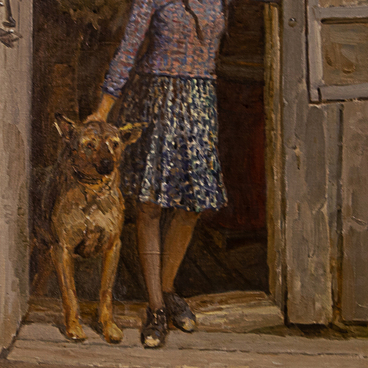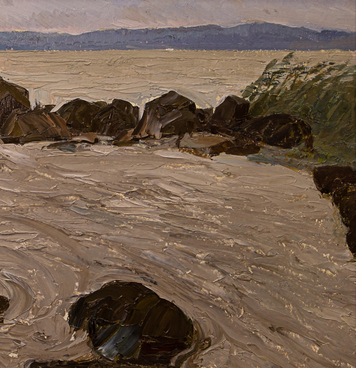Nikolay Nikolayevich Chuvakhin was born in the town of Malaya Vishera (the Novgorod region) in 1947. The young painter’s manner of working was formed under the influence of his teacher Yevgeny Pavlovich Melnikov at the Tashkent Art College. Later, Chuvakhin enrolled in the Ilya Repin Leningrad Institute for Painting, Sculpture and Architecture, where he attended the studio of Yury Mikhailovich Neprintsev, the People’s Artist of the USSR.
In 1977, together with other talented and idealistic art graduates, Nikolay Chuvakhin went to Komsomolsk-on-Amur. This city became his starting point for creative trips to Sakhalin, Kamchatka, and the Kuril Islands; the artist also witnessed the construction of the Baikal-Amur Mainline.
Numerous dreamers from all over the Soviet Union, who were eager to experience the harsh conditions of the permafrost, responded to the call to build the Baikal-Amur Mainline — the railroad that ran through Eastern Siberia and the Russian Far East.
This painting by Nikolay Chuvakhin is dedicated to those people. Its meaning can be deduced from certain elements. The depicted people of about the same age are young and energetic; most likely, they have accessed the place of research either by using Komsomol travel tickets or an invitation from the management of this large construction project. The people’s clothes and headdresses point to the weather being cold; their things, unloaded from the helicopter, indicate that they are about to settle in these places for a long time and are not afraid of any challenges.
The painting also demonstrates the artist’s talent as a landscape and portrait painter: he is equally delighted with the majesty of nature and the dedication of people.
Nikolay Nikolayevich Chuvakhin’s creative philosophy is based on integrity, the importance of beauty and goodness, and the aspiration to preserve and perfect the Russian school of realism.
When talking about his work, the artist noted that he preferred the enlightening spirituality over “the mysterious and enigmatic”, and that he strove to make his art relatable to anyone, be it “an educated viewer, a child, or a peasant.”
In 1977, together with other talented and idealistic art graduates, Nikolay Chuvakhin went to Komsomolsk-on-Amur. This city became his starting point for creative trips to Sakhalin, Kamchatka, and the Kuril Islands; the artist also witnessed the construction of the Baikal-Amur Mainline.
Numerous dreamers from all over the Soviet Union, who were eager to experience the harsh conditions of the permafrost, responded to the call to build the Baikal-Amur Mainline — the railroad that ran through Eastern Siberia and the Russian Far East.
This painting by Nikolay Chuvakhin is dedicated to those people. Its meaning can be deduced from certain elements. The depicted people of about the same age are young and energetic; most likely, they have accessed the place of research either by using Komsomol travel tickets or an invitation from the management of this large construction project. The people’s clothes and headdresses point to the weather being cold; their things, unloaded from the helicopter, indicate that they are about to settle in these places for a long time and are not afraid of any challenges.
The painting also demonstrates the artist’s talent as a landscape and portrait painter: he is equally delighted with the majesty of nature and the dedication of people.
Nikolay Nikolayevich Chuvakhin’s creative philosophy is based on integrity, the importance of beauty and goodness, and the aspiration to preserve and perfect the Russian school of realism.
When talking about his work, the artist noted that he preferred the enlightening spirituality over “the mysterious and enigmatic”, and that he strove to make his art relatable to anyone, be it “an educated viewer, a child, or a peasant.”


